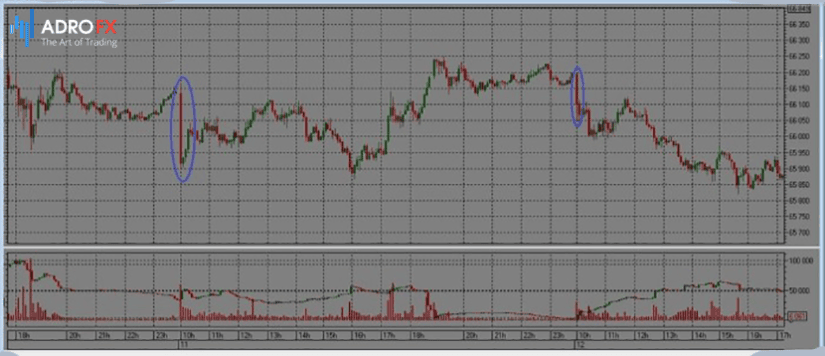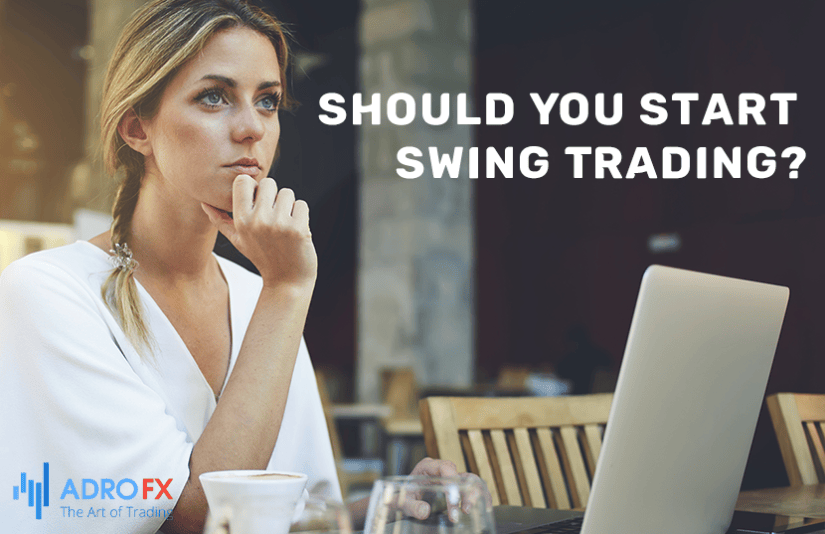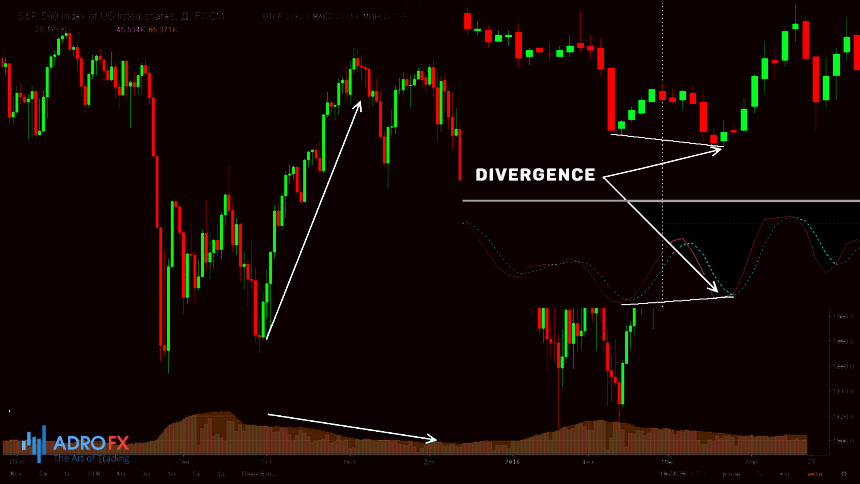Introduction to Swing Trading

Trend trading is one of the safest ways to benefit from the foreign exchange market. It is based on the fact that traders, like the crowd, create a mass movement, pushing out of the market all those who swim against the current.
If you compare the trend and the river, you'll understand how difficult it is to go against the current even in shallow waters, not to mention the boiling streams of big mountain rivers. It is the same in trading - following the crowd in this case allows you to increase your capital. If you go with the flow, you will be carried without any effort to the necessary place. All that remains is to understand - when to enter this river and in what direction the trend is moving. There are a lot of trend trading strategies that allow us to find a solution to this problem. One of them is swing trading.
What is Swing Trading
The trading community owes the appearance of swing trading to J. Taylor and his book "Taylor's Trading Technique" written in the '50s. The trades in swing trading aim to take the price swing (range) of the dominating trend. However, a successful position can be held for several days, while the risk, on the contrary, is stopped quickly. Any trend consists of a phase of movements in its direction and correction phases. The swing trader tries to enter a position in the direction of the trend after the correction is completed at the moment when the impulse phase of the trend begins its development. The opposite trend line is usually taken as the goal of the movement.
Thus, classic swing trading is based on technical analysis, and its basis is the understanding of including graphical analysis and analysis of the trading volume. Also, swing traders use indicator analysis if necessary, and sometimes fundamental analysis as well (because news and statistics can be the drivers which activate the price impulse).
Swing Trading Peculiarities
Based on the main objective of swing trading - the catching of the trend swing (and it can be realized not in a single day), a trader should have a strategy for making a decision on a trade, a system of setting movement targets, securing gains (possibly by portions), and they should also decide whether it is reasonable to move a position overnight.
As for the system of making decisions about entering a position, it is necessary to understand the structure of the dominating and nested trend and to work in the direction of the dominant trend, when the corrective trend begins to "exhale". Trading volume, indicator divergences as well as technical analysis figures indicating a trend reversal (change of a correction phase) are indicators of this. That is, in a swing, the trader observes both the long-term (main) trend and the short-term (correctional) one, and it is advisable to output the traded asset in two-time frames or to switch between the higher and the lower time frames. In this case, it is advisable to place the trade when the price indicates the completion of the correction, which manifests itself either by a reversal figure of the technical analysis at the end of the correctional phase, by indicator divergence, or by the inflow of volume at the beginning of the main trend impulse.
Then, being in a successful position, the swing trader tries to achieve and secure gains by fixing parts of the position as the price approaches the extremums. Traders usually distinguish three phases of securing gains – by analogy with distinguishing three impulse waves in a trend (though it is not a strict rule). When fixing the first part of the return, traders move their stop order to the entry point, thereby leaving themselves at least a fixed part of the gain. When fixing the second part, stop orders are moved to the first fixing zone, thus accumulating returns.
Deciding to Hold Positions Overnight
As the price movement develops, a swing trader must decide whether it makes sense to roll over a position overnight or whether it is worth locking in earnings and looking for new opportunities the next day. Here it is worth recalling a well-known saying: Your tomorrow begins today. That is, you should analyze the trend movement of the current day and weigh its potential. The first rule of position transfer: the transfer is possible only when the position is deep in the gaining zone. The fact is that the opening candle is sometimes very strong (or the market opens in a gap) and it will be possible to exit by a stop only at the candle's extremum. That is, a large slippage is possible, which is risky for the trader. Of course, a similar powerful opening impulse can occur in the trader's position direction, as well as the market may open at about the closing point, so it is worth carefully weighing the decision to leave a position overnight.

Factors that can provoke an impulse in the direction of the trend are clearly positive news during the current day, in which a large volume entered the market, consistently moving the price in the direction of the trend. A significant factor in the continuation of the trend is to close the market above the extremums reached earlier, which will provoke a group of opponents to close on stops and thus continue to move in the trend. It is desirable that the trend before the closing of the day still had the potential to move, that is, the closing did not occur on the opposite trend line. Also, it is necessary to pay attention to the position of correlating assets, which should confirm the trend of the traded asset. If these conditions are met and the position is deeply successful, then it is carried over to the next trading session, which is allowed in swing trading..
Advantages and Disadvantages of Swing Trading

There are several advantages of swing trading. One of the most attractive is that you do not need to spend a lot of time in front of the terminal, constantly monitoring charts and placing orders. Sure, you can practice swing trading in lower time frames as well, but it will not be as effective.
By practicing swing trading, you learn to read the market. You don't need indicators that are always lagging. Such an approach is more effective, because, as we know, the main postulate of technical analysis – the price discounts everything.
Psychologically swing trading is most suitable for emotional traders who often trade on intuition. Because it's enough to control the market just once a day (with Stop Loss and Take Profit), the temptation to enter the trade in the wrong place is practically eliminated.
As such, the technique has no disadvantages, but it is not suitable for inexperienced traders. It is important to learn to read the market first, foresee price behavior, and correctly determine levels. It demands time and certain efforts.
Swing trading is a whole group of techniques, which are based on one general principle – trade with the trend, enter on a pullback. This methodology has been successfully operating in the currency market for a long time, but it is not suitable for everyone. Don't be in a hurry to trade with the swing method if you are a beginner. Study the market first, get acquainted with fundamental analysis and the Price Action system, and only after that, start swing trading.
Swing Trading Strategy Example
A couple of hours or several days can pass between entering and exiting a trade. You should enter the trade only if a strong trend is detected. It is necessary to ignore the moments of stagnation, or on the contrary, too high volatility of the market.
We should say that there is no special swing trading strategy. All methods are based on the main principles of trading during the correction. The trader waits for the maximum pullback of the price and then opens a position in the direction of the global trend. However, there are several rules and laws which should be observed if you decide to stop at this trading method:
If the right time is chosen to open the trade, the price will immediately go in the direction of earnings. If within a couple of hours after entering the market the price has gone in the opposite direction and the trade has become losing, then you should exit the market and look for a better opportunity to open a new position.
Impulse growth of the price to return is recommended to be fixed immediately after the movement has reduced its strength. For example, if immediately after opening a position to buy the price suddenly "burst" upward, then you should immediately secure gains and close the position. Most likely, after such a spurt the price will make one more pullback, and you will have an additional opportunity to open one more position and achieve more yield from the market.
For each order, it is necessary to establish a protective Stop Loss order. Return can be fixed both with standard Take Profit and by Trailing Stop.
If at the moment of termination of the current trading session your trade is successful, it can be transferred to the new day. The negative position should be closed on the day of its opening.
You should not open trades when the market is opening or when important economic news is released. It is better to close open positions before the release of significant news that can influence the trend.
If there is an obvious change in the trend, a trade should be closed manually, without waiting for Take Profit or Stop Loss to trigger.
You should not open a position if you are unsure of the main trend. In this case, the possibility of achieving a yield can be compared to winning at roulette – everything will depend only on luck.
For trading, it's best to choose the major currency pairs with the minimum spread. When using leverage, choose the lowest one. You may trade on 2 or 3 assets at the same time, which will increase the number of signals and deals, and therefore the gain itself.
Swing Trading: Market Entry Points
When trading applying a swing trading strategy, it is important to learn how to choose the right moment to enter the market. This is done in several stages. First of all, it is necessary to determine the trader's active zone.
The price channel (Keltner Channel or Bollinger Bands) or the distance between Moving Averages can be used as the trader's active zone.
For example, the chart below shows that the active zone of the trader will be the distance between the two Moving Averages: SMA (10) and EMA(30). This is the zone in which the trader (provided that the price has come to the designated area) decides about the advisability of entering the market.

If the price is in the active zone, it means that there was sufficient rollback to open a trade, and it is necessary to analyze the entry point and set the exact parameters of the position. You should refrain from opening trades in two cases:
If the price has fallen below EMA30. A deep correction or the emergence of a new trend is possible.
If the price has risen above SMA10. The price has not made a sufficient pullback, the market is in a calm state.
When the price is in the active zone, various trading tools from the candlestick to technical analysis are used to determine the entry point. Let us consider them in detail.
The Color Levels indicator can be used in swing trading. It adds resistance and support levels on the chart, which can be used for setting Stop Loss and Take Profit, as well as for determining the moment of price correction or pullback beginning.
Money Management While Swing Trading
In swing trading, the standard risk and money management strategies applicable to any trending methodology are used. They are as follows:
- Risk up to 2% of the deposit per trade;
- The ratio of Take Profit and Stop Loss should be no less than 2 to 1.
Let us consider such money management for medium-term trading. Let us take a deposit of $1000. If there is a trend movement and the possibility of a good entry point, the return for the trade will be $80 with a possible Stop Loss of $20. Thus, the ratio will be 4 to 1. This is clear proof of the lucrativeness of trend swing trading.
For more flexible trading, a Trailing Stop can be used, which replaces both Stop-Loss and Take-Loss orders at the same time. The second option manually move Stop Loss when the price reaches new key levels from breakeven to gain.
Swing trading is a low-risk way to increase your deposit with minimal trades. Trend trading implies simplicity of positions and short terms of orders' validity. It is enough to swim with the current and place trades in the direction of the main trend. It is forbidden to trade against the market. It is also not allowed to trade during the flat price movement. This is why swing trading is considered to be exclusively day trading. At nighttime, when the price goes flat, finding a successful entry point will be extremely difficult.
Should You Start Swing Trading?
Finding the right style of trading depends on your personality as well as your trading preferences.
Using swing trading strategies, you will hold your trades for days or even weeks. Naturally, the risks in this case increase. As an option, you can close a part of your position if important news come out or you need to roll over a position through the weekend.
You will not have many trading opportunities and the number of your trades will be limited. On average, you can expect between 10 and 15 trades a month. However, the returns from these trades can be much higher than with intraday trading.

Swing trading will suit you if:
- You do not mind holding positions for several days.
Most swing trades last from a few days to a few weeks. That means holding positions overnight and sometimes even over the weekend.
Of course, there are several ways to manage your risk that will allow you to hold positions for longer periods of time. One way is to simply close your position before the weekend if you know the market may be volatile.
- You want more freedom.
On average, you won't need more than 30 or 40 minutes to review your charts throughout the day. Spending more time is not necessary.
- You don't mind opening fewer trades, but you earn more on each one.
Since swing trading works best in higher time frames, your options are limited. You can expect to get five to ten good trades each month.
However, the payoff from them can be much higher than those who trade intraday. For example, my minimum risk/reward ratio is at least 3. That means that for every 1% risk in the account, we get a 3% return.
- You are looking for a more measured trading style.
When it comes to trading, slow trading is not a bad thing. In fact, a slower style gives you more time to make decisions, which leads to less stress and anxiety. So if you're looking for a more relaxed way to trade the market, swing trading may be the solution for you.
- You have a job or study.
This is the kind of freedom in trading that swing trading can give you.
Swing trading will not suit you if:
- You prefer active trading and do not like to wait.
Relaxed and disciplined traders win in swing trading. If you like to place more trades and you're bored of waiting around for days, then this style of trading is definitely not for you.
- You like to secure frequent gains from the market.
Day traders can place a lot of trades during the day, but their return potential will not be as high as in swing trading.
- You don't like the idea of carrying a position overnight or through the weekend.
If you can't sleep knowing that you have your funds left in the market, it's time to reduce your position size or leave swing trading.
- You want to know if you are right or wrong immediately.
Long-term trades require patience. It can take days, and sometimes weeks before you know if your analysis was correct. During this time, you will have to get your will in your fist and not close your trade early.
- You get too worried when the price goes against you.
In most cases, the price will not immediately move in the direction you choose. All traders face drawdown in one form or another, regardless of their trading style. However, a drawdown for a swing trader can last for a much longer period of time.
Tips For Swing Trading
Tips from personal practice, so we take everything critically and apply it to the situation:
- If we assume that the market works in the classical 5-day Elliott chart (3-4 days of trending and 1-2 days of pulling back), then the entrance is performed after 1-2 average swing periods (for buying – from above, for selling – below).
- we use any strong price breakout near strong price levels for entry, after the level retest and the corresponding situation on the volumes.
- when holding successful positions, the stops should be set so as to minimize the loss from a possible overnight gap.
- the recommended time frame for the analysis should be at least H4, to support the position – at least 2-3 days, a shorter period reduces the quality of analysis. We use the cross-confirmation of the signals of technical indicators, as well as all kinds of divergence.

- it is necessary to understand and be able to use to see all the reversal patterns on a price chart, not only the basic ones (dojis, harami, hammers) but also multicluster patterns. It is very advantageous to combine long-term swing trading tactics and short-term VSA because their analysis principles are almost the same.
Conclusion
The result of any swing trading strategy hardly depends on the level of deposit and trading asset. The main thing is to make a good forecast for the next 3-5 days. Despite the fact that this technique is close to every trader, it requires experience in trading both in trends and in the range, confident knowledge of all types of analysis, the ability to switch between 2-3 trading strategies, and strong nerves to hold a position for several days. That's why it's not recommended for beginners.
About AdroFx
Being a well-established brokerage company, AdroFx offers the best trading conditions to its clients from 200 countries. Founded by experts with a couple of decades of overall experience, AdroFx is one of the best platforms on the market for shares trading. Either a newbie or experienced trader, both will find here what they are looking for since the company provides various trading accounts for different trading styles and goals.









